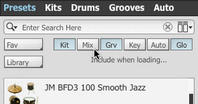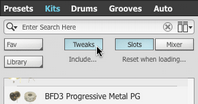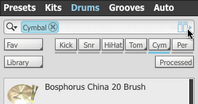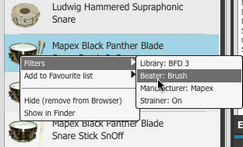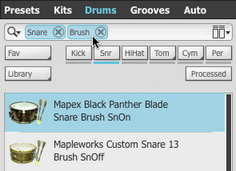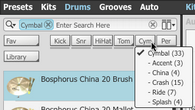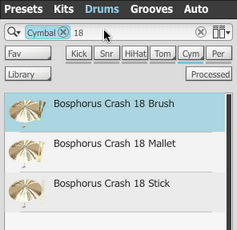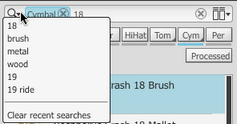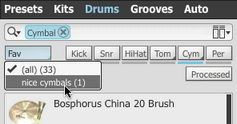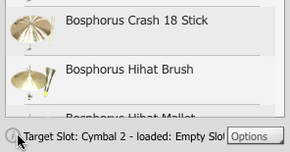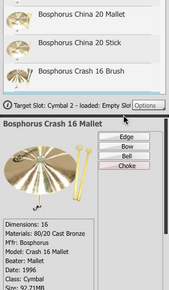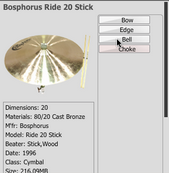Loading options for Presets and Kits
Include when loading...
Presets
|
When the Preset Browser is visible, several toggle switches are shown at the top of the Browser panel. These allow you to activate or deactivate certain elements when loading Presets. By default, all elements of Presets are loaded - effectively replacing the entire previous state of BFD3. By deactivating its switch, any of the following elements can be prevented from loading: |
• Kit (Drums and Drum Editor settings)
• Mix (Mixer)
• Grv (Groove Palette, Drum Track and Groove Editor settings)
• Key (Key Map)
• Auto (Automation map – MIDI CC, note and host automation assignments)
• Glo - (Global settings, Session preferences)
By default, the Key and Auto buttons are deactivated, because typically it would not be desirable to keep changing these settings when trying different Presets.
Kits
|
In the Kit Browser, if the Include... Tweaks button is activated, the Drum Editor settings for each Drum in the Kit are loaded. If the button is deactivated, the Drum Editor settings are reset to factory defaults when a Kit is loaded. |
Reset when loading... (Kits only)
|
These buttons toggle whether certain elements in BFD3 are reset when loading a new Kit. Slots If the Slots button is activated, any current slots not which are used in the kit to be loaded are removed. If the button is deactivated, only slots used by the kit are affected - unused slots remain completely unaffected. |
Mixer
If the Mixer button is activated, all mixer channels are reset when the kit is loaded - unused mixer channels including Aux channels are deleted and the Drum channels used by the Kit are set to factory defaults.
If the button is deactivated, the current mixer configuration and settings remain unchanged.
Processed (Drums only)
This button toggles visibility between regular Drums and Processed Drums in the Browser listing.
Processed Drums are regular Drums saved with additional Drum Editor and mixer channel settings for a more produced, mix-ready sound compared to that of a raw underlying Drum.
Processed Drums are shown separately to regular Drums to reinforce the fact that loading them changes the entire contents of the Drum channel including mixer settings, which is much more difficult to overcome than returning to the previous Drum if you decide you don't like the one you just loaded.
Filtering the browser listing
The Browser's filtering functions allow you to narrow down the Browser listing according to various criteria.
Click the Filters button to open the Filters panel - this panel allows you to see all available filtering criteria simultaneously.
Many filters are also available on the main Browser panel in the form of Quick-filter drop-down menus - see below.
Filters panel: Drums
The Filters panel shows all filtering criteria simultaneously. The numbers in brackets represent the number of items that would be available when specifying each of the filtering criteria.
|
The Drums Browser offers a number of criteria with which to filter the listing. Favourites Favourites are user-defined groups to which any Drums can be added - working with Favourite Lists is discussed below. |
Library
The Library field refers to the original library to which the Drum belongs - for example, the BFD3 Core Library content represents a library, as does the BFD2 factory content, or any expansion pack.
Class
The Class field represents the Drum class or type - whether it is a kick, snare, tom, cymbal, hihat or percussion instrument. Toms and cymbals also feature sub-classes.
By changing the Class that is shown by default for the currently selected slot, you can load any type of Drum into it - not just those intended for the particular slot type, but please note that certain caveats apply when doing so. See the 'Possible loading problems' section below for usage guidelines.
Beater
The Beater type varies according to various Drum classes.
Manufacturer
This filter type lets you see all Drums by certain manufacturer(s).
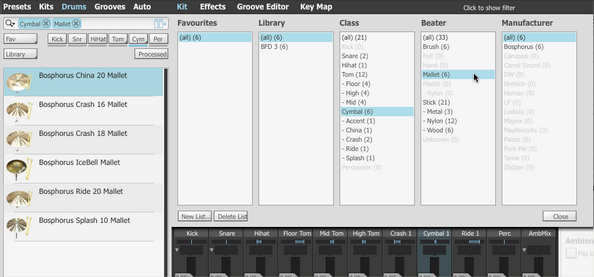
•Filtering the listing to display only cymbals played with mallets
Filters panel: Kits, Presets
The Kits and Presets tabs of the Browser feature only 2 filtering criteria: Favourites and Library.
Setting filters according to Browser items
The Browser context menu contains a Filters sub-menu which lists the filtering criteria for an item in the Browser listing. |
Selecting the Beater type, for example, adds it to the Search bar and filters the Browser listing accordingly. |
Quick-filters: Class filters (Drums only)
|
The Drums Browser features dedicated buttons which display drop-down menus for filtering the Drum Class (and sub-class in the case of toms and cymbals) - these achieve the same function as using the popout Filters panel. When the Focus browser setting is activated in the Options menu, the corresponding Class filter button is enabled when selecting a Drum slot if the Drums Browser is currently visible. Double-click the Drum slot to bring the Drums Browser into view as well as enabling the relevant Class filter. |
Quick-filters: Favourites and Library filters
The Presets, Kits and Drums Browsers all feature dedicated buttons which display drop-down menus for setting the Favourites and Library filters. The Favourites system is described below.
Searching
|
Using the Search text-box is another way of narrowing down the Browser listing. Click the text-box and type a search term - the example shows typing "18" while viewing all cymbals to find all available 18" cymbals. Searches operate in conjunction with the Filters described above.
|
The Recent searches drop-down menu lists all recent searches for the Drum type. Use the Clear recent searches function to remove all entries from this menu.
Favourites
Right-click on a Browser item in order to display the Add to Favourite list function. This is a sub-menu showing all available Favourite Lists to which to add the selected item. In the above example, no groups have yet been set up. Click the Create New List... function to display a dialog prompting you to enter a name for the new Favourite List. |
The item is added to the newly created Favourite List, which is now shown on the Fav menu and also in the Filters panel under the Favourites column. When the List is activated, the Browser listing is filtered to show the items in the List. |
Search/Filter status and removal
|
Each search term or filter that is active is represented within the search bar at the top of the Browser panel. To deactivate any item, simply click the Remove button at the right side of each item - the item is then removed from the active searches/filters. |
Other controls
Target Slot indicator (Drums only)
|
The Target Slot indicator displays information about the destination Drum slot: Target Slot This part of the indicator shows which slot is currently set as the destination for previewing-in-place and loading when a Drum is selected in the listing. Currently loaded in Slot This part of the indicator shows the name of any Drum already loaded into the slot. |
Browser context menu
Right-click on any item in the Browser listing to display the Browser context menu.
Filters
This sub-menu provides a convenient way to set Filters according to the selected Preset/Kit/Drum. For Presets and Kits, the sub-menu shows the Library Filter settings. For Drums, the Library, Beater and Manufacturer Filter settings are shown. Click any of these items to filter the Browser listing according to the Filter setting.
Add to Favourite list
This function is used for the Favourites system - see above.
|
Hide (remove from Browser) This function removes the item from the Browser listing. No files are deleted - instead, the item is hidden until the next time the content location which includes them is rescanned. To remove items permanently, their files must be deleted from disk. The location of each file can be seen using the Info display panel (see below) or the Show in Finder / Show in Explorer functions. Change Library This function is available only for user-generated Presets and Kits. It allows the Library tag of the file to be set - an existing Library tag can be used or a new tag can be created by using the Enter Library name function. |
Show in Finder (Mac)
Show in Explorer (Windows)
This function displays the selected file within a system file window (Finder on Mac, Explorer on Windows).
Options menu
|
Most functions in the Options menu are available only when the Drums Browser is currently visible. |
Import samples (Drums only)
Clicking this button opens the Sample import panel with which you can create single-articulation mono or stereo Drums with multiple velocity layers from a set of one of more samples. These Drums can be loaded from the Browser into any BFD3 session after they are created.
Audition when clicking Drum (Drums only)
Enabling this setting results in the main articulation of each Drum being automatically previewed as it is selected in the Browser.
Preview drum on channel when selected (Drums only)
Activating this setting enables the preview-in-place functionality of the Browser.
Focus browser on selected channel (Drums only)
With this setting activated, selecting a Drum slot or Drum mixer channel results in the relevant Drum type being shown in the Browser listing. This means that with a kick slot selected, the Browser shows available kicks, when a snare slot is selected, the available snares are shown, and so on.
Sort by...
|
The Sort by function offers a number of ways to order items in the Browser. |
Presets and Kits can be sorted by Name, Folder or Date Modified (again, this is particularly useful for user Presets/Kits). The Folder setting is particularly useful if user presets are arranged within sub-folders in the user location or if factory or expansion pack Presets/Kits have been manually rearranged into sub-folders within the factory location.
Drums can be sorted alphabetically by Manufacturer name or by their Dimensions.
Confirm Preset loading (Presets only)
Deactivate this setting to disable the confirmation prompt when loading a new Preset.
Confirm Kit loading (Kits only)
Deactivate this setting to disable the confirmation prompt when loading a new Kit (or when using the Load random Kit function in the File menu).
Browser info display
• Resizing the Info display
•Auditioning a Bell articulation for a ride cymbal |
Activating the Info display button enables the Info display at the lower part of the Browser. This display contains information about the currently selected item in the Browser. For Drums, it also has additional functions for manually auditioning individual articulations. Click and drag up/down on the separator above the Info display to resize the area of the Browser devoted to the actual item listing and the Info display panel at the bottom. Presets, Kits The info display shows information about which Drums exist in each of the slots within a Preset or Kit. Any contained Drums which are invalid - unauthorized, not present or corrupt - are listed in red. The location of the Preset or Kit file is also shown. Drums The Info display shows information about the selected Drum and audition functions for its articulations. Articulation audition strips Each articulation present within the selected kit-piece can be previewed by clicking its Audition strip. Click towards the left of the strip for lower velocity layers, and towards the right for higher layers. Info The info box shows factory information about the selected kit-piece. •Dimensions •Materials •manufacturer •Model/name •Beater type •Production date •Class •Size on disk •Location in the data path •Factory Library |
Possible loading problems
Even though each Drum slot in BFD3 is intended for a certain type of Drum - be it a kick, snare, hihat, cymbal or percussion instrument - it also allows you to change the Drum Class filter to load any Drum into any slot. When building arbitrary kits in this way, you should be aware of the following potential issues:
1. Articulation mappings
Because different Drums have different numbers of articulations, the Key Map may not feature enough articulation mappings for the non-standard Drum.
If you load a Snare into a Tom slot, for instance, the slot holds 6 Snare articulations although only 3 are actually mapped. The extra snare articulations need to be mapped to MIDI notes before they can be triggered.
If, on the other hand, you load a Tom into a Snare slot, any mappings which exist for the Snare that do not have a logical equivalent for a Tom 'fall back' to a suitable available tom articulation.
It is not recommended to load different types of Drums into the Hihat slot. This slot is specially designed to load Hihats and there is no real reason to load any other type of Drum into this slot.
If you have an electronic drumkit, you should be aware that the Hihat slot is the only slot that supports variable hihat control. Likewise, only the Snare1 slot supports positional sensing control.
2. Grooves
Even though Groove events do not rely on articulations being mapped, they are nevertheless usually intended for a certain type of kit-piece articulation. In the vast majority of cases, Grooves are designed for kits that follow suggested kit-piece slot uses.
Like articulation mappings, Groove events fall back intelligently to suitable articulations in the loaded kit-piece, so this can be good for experimentation. Please bear in mind, however, that a Groove simply may not make sense when played with a completely different type of kit configuration.
